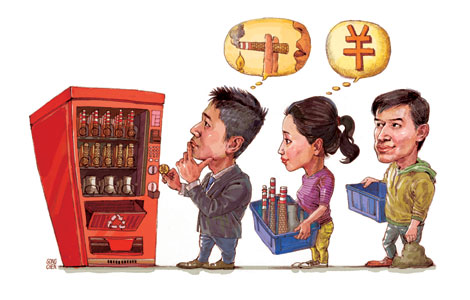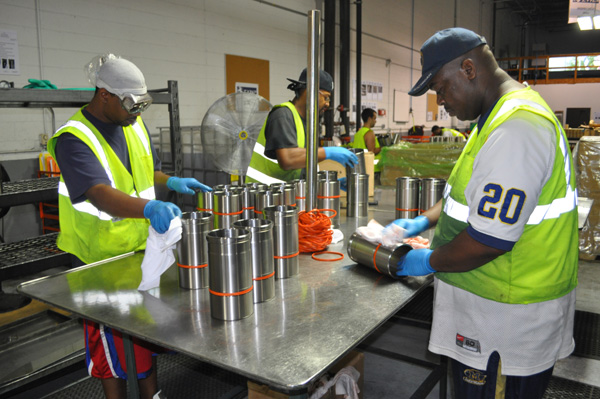Detroit: Gold mine for China
Updated: 2013-07-30 08:11
By Michael Barris (China Daily)
|
||||||||

|
Workers prepare engine cylinder liners for packaging at the US distribution arm of ZYNP China Manufacturing, in Romulus, Michigan, near Detroit. Michael Barris / China Daily |
Despite the Motor City's bankruptcy filing last week, its abundant engineering talent and car history lure Chinese automobile companies seeking global expansion, as Michael Barris reports from Detroit.
Detroit is still Motor City - at least to Chinese automotive companies doing business here.
In the past decade, dozens of them have been drawn to the area, not just because of its existing infrastructure, supply network, abundance of skilled workers or tax benefits, but because of Detroit's pivotal role in automobile history.
"It is the center of modern vehicle technology," proclaims John Yang, chief metallurgist with ZYNP International, the US distribution arm of engine cylinder-maker ZYNP China Manufacturing. The facility is located in Romulus, Michigan, about 25 miles southwest of Detroit. "This area still has its strength in technology and talent," Yang said in an interview.
Overwhelmed by a debt of at least $18 billion, Detroit filed for Chapter 9 bankruptcy protection last week, the largest such filing in US history. A legal muddle created by a county judge's ruling that the filing was unconstitutional was lifted on Wednesday when a federal bankruptcy judge cleared the way for the case to go forward without legal challenges.
As China's leadership boosts research and development for auto parts, mandated by the latest five-year plan (2011-15), Chinese automotive companies have stepped up their activity around Detroit, doing everything from R&D on behalf of parent companies back home to making parts exclusively for US auto makers.
Their arrival is welcomed by the state government, led by Republican Governor Rick Snyder, former chairman of California computer-maker Gateway Inc, and ex-chairman and CEO of Michigan venture-capital firm Ardesta LLC. The first-term Snyder administration sees China's interest in learning more about automobile production as a chance to create jobs for a hard-hit region.
Michigan was in the grip of a deep, decade-long recession through 2010. The state, whose economy is disproportionately affected by the automotive industry, lost nearly 218,000 manufacturing jobs from 2000 to 2005. It suffered further near the end of the decade when auto sales at General Motors, Ford and Chrysler plunged because the Detroit Three couldn't compete against fuel-efficient Japanese cars at a time of high gas prices. The US industry's woes were symbolized by the Chapter 11 bankruptcy filings of GM and Chrysler in 2009, moves now seen as necessary steps in the auto industry's recent resurgence.
More and better jobs
Last year, the Great Lakes State, struggling to recover from the economic slump, exported $3.2 billion of goods and services to China, a 25 percent jump from 2011 and lagging behind only Canada and Mexico. Michigan received more than $917 million in capital from China in 2012 to become one of its top 10 direct-investment states.
"More and better jobs are created both by promoting Michigan exports to China and by attracting Chinese companies to locate operations in Michigan," said Michael Finney, president and CEO of the Michigan Economic Development Corp, a public-private partnership that provides grants, loans and other economic assistance to businesses that make investments or create jobs in the state.
Finney calls China's economic growth "an opportunity" for Michigan. Chinese officials feel the same way. During a recent visit to the Detroit Chinese Business Association in Troy, about 40 kilometers north of the city, Zhao Weiping, China's Chicago-based consul general to the Midwest, called Michigan "an important business partner of China".
The Chinese auto industry's increasing presence in the Detroit suburbs continues a pattern of auto-production decentralization that started in the 1920s and shifted into high gear in the 1940s and 1950s, when GM, Ford and Chrysler expanded into new facilities around Detroit. That move helped push auto production into a truly national industry, responsible, at the city's height at mid-century, for one in every six US jobs.
Detroit's connection with a golden age of American automobile manufacturing fascinates Chinese automotive executives.
"Here in Detroit, we have a tradition," said Jerry Xu, president of the Detroit Chinese Business Association, a nonprofit business network that fosters bilateral business relationships between US and Chinese companies. "We have a lot of history and experience that no other place can have. That is why Detroit is always respected by the Chinese as the place for the automotive industry."
The business association estimates that about 100 Chinese firms, mostly in the auto industry, are active in the region. Those who come here typically aim to make a name for themselves in the global marketplace via Detroit, which has retained its legacy as a model for American innovation, notwithstanding its long decline and financial problems, Xu said.
Understanding that the path to success is through the Motor City, "they have to find a way to push through and come to the US, to the Michigan area, to realize that aspiration," Xu said.
Sometimes, he said, large companies come with abundant talent and experience in doing business in the US. But "there are a lot of Chinese medium and small businesses that need help when they come", Xu said.
The area's abundant engineering talent is a magnet for Chinese auto-related companies looking to increase their knowledge of automobile production.
Hong Su, vice-president in charge of research at the United States R&D center for Chinese automaker Changan, in Plymouth, Michigan, about 40 km west of Detroit, said he has hired about 20 engineers with US auto industry experience in the last few years because of their expertise in developing vehicles.
Most Viewed
Editor's Picks

|

|

|

|

|

|
Today's Top News
Spain investigators: Train driver was on phone
Apple faces more staff abuse charges
Spending surge for renewables
Beijing and Canberra to resume trade talks
Top leader vows to meet growth target
2,290 disciplined for extravagance
Japan diplomat seeks to mend ties
Draft rule requires a license for dog breeding
US Weekly

|

|

















